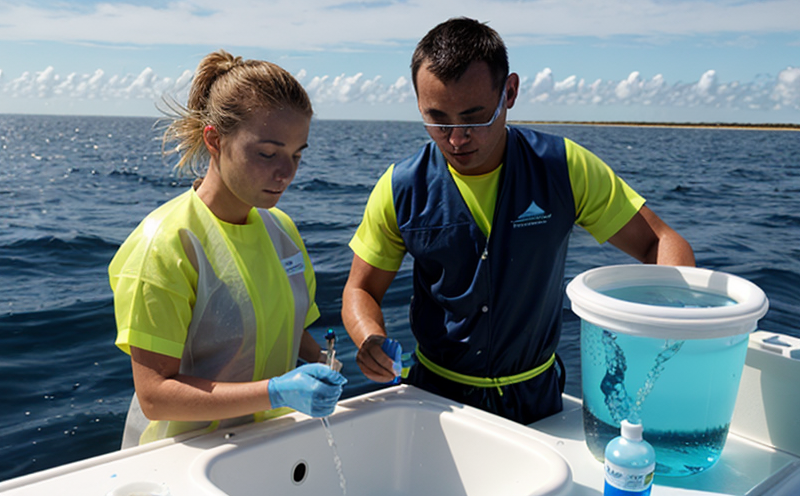ASTM D1125 Conductivity Test in Seawater
The ASTM D1125 test method is a standardized procedure designed to measure conductivity in seawater, which is essential for understanding the electrical properties of water. Conductivity serves as an indicator of the concentration of ions present in the water, reflecting its overall purity and salinity level.
Seawater is a complex electrolyte solution that contains various dissolved salts such as sodium chloride (NaCl), magnesium sulfate (MgSO₄), calcium carbonate (CaCO₃), among others. The conductivity of seawater directly influences marine life, coastal ecosystems, and the design of offshore structures. Accurate measurement of conductivity helps ensure compliance with environmental regulations and supports decision-making in industries such as aquaculture, oil & gas exploration, and maritime engineering.
The ASTM D1125 method specifies a procedure for measuring electrical conductivity using a standard cell constant and temperature compensation factor. This ensures that the measured values are comparable across different laboratories and instruments. The test involves calibrating the conductivity meter with a standard solution before taking measurements from seawater samples.
In practice, the process begins by collecting representative water samples from various depths or locations within the marine environment. Proper sample handling is crucial to avoid contamination, which can skew results. Once collected, the samples are transported to the laboratory for immediate analysis or stored under controlled conditions until testing. The conductivity meter used should be calibrated according to ASTM D1125 standards before each use.
Calibration involves preparing a series of standard solutions with known conductivity values and comparing their measured results against these reference points. Temperature plays a critical role in this process because it affects the electrical properties of water. Therefore, all measurements must account for temperature variations using the appropriate correction factors outlined in ASTM D1125.
The use of advanced analytical instruments like conductance meters equipped with precise cell constants ensures accurate readings. These devices often come with built-in software that facilitates data logging and calculation of corrected conductivity values based on the sample's temperature.
Understanding the results obtained from ASTM D1125 testing is vital for several reasons. For instance, it informs decisions regarding water quality standards in coastal areas, supports environmental impact assessments (EIA) related to offshore activities, and aids in optimizing operations within the aquaculture sector where maintaining optimal salinity levels is crucial.
Moreover, accurate conductivity measurements play a significant role in preventing accidents at sea by ensuring that ships navigate through waters with appropriate salinity levels. This helps avoid situations where vessels might experience increased friction or other challenges due to changes in water properties.
Eurolab Advantages
- ISO/IEC 17025 accreditation ensuring reliability and traceability of results
- State-of-the-art equipment calibrated to international standards
- Experienced technical staff with specialized knowledge in marine water analysis
- Comprehensive quality management system that guarantees consistent accuracy
Why Choose This Test
The ASTM D1125 conductivity test is indispensable for ensuring compliance with environmental regulations and supporting sustainable practices in the marine industry. By accurately measuring seawater conductivity, businesses can make informed decisions that protect both their operations and the surrounding ecosystem.
For example, aquaculture farms rely heavily on precise knowledge of water salinity to maintain healthy populations of fish and other aquatic organisms. Similarly, offshore drilling companies need accurate data about the electrical properties of seawater to prevent equipment malfunctions or failures during critical operations.
In addition to its practical applications, this test also contributes significantly towards environmental protection efforts. Regular monitoring helps identify trends in oceanic pollution levels early enough for proactive interventions. This information is invaluable for policymakers looking to implement effective strategies aimed at preserving marine biodiversity and promoting cleaner oceans globally.
Environmental and Sustainability Contributions
- Maintains ecological balance by ensuring proper salinity levels in coastal environments
- Promotes responsible use of resources through informed decision-making based on accurate data
- Aids in tracking the impact of human activities on marine habitats and ecosystems
- Supports efforts to minimize pollution risks associated with industrial processes involving seawater





